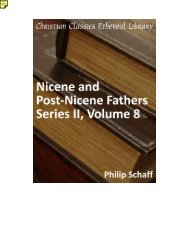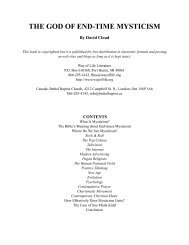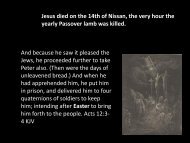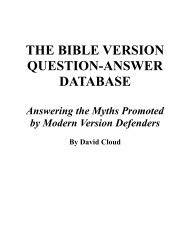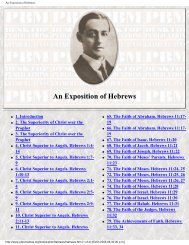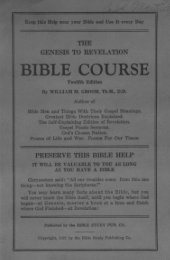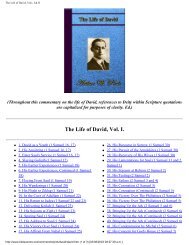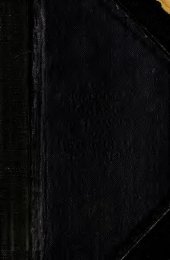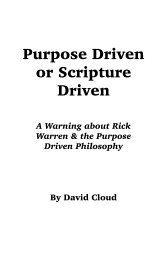A guide to the textual criticism of the New Testament - Holy Bible ...
A guide to the textual criticism of the New Testament - Holy Bible ...
A guide to the textual criticism of the New Testament - Holy Bible ...
You also want an ePaper? Increase the reach of your titles
YUMPU automatically turns print PDFs into web optimized ePapers that Google loves.
THE INFANCY.<br />
only <strong>the</strong> Greek. Each successive edition underwent correction,<br />
but <strong>the</strong> last did not differ much from <strong>the</strong> fourth.<br />
Erasmus died at Basle in 1536.<br />
3. The editions <strong>of</strong> Robert Stephen, Theodore Beza, and<br />
<strong>the</strong> Elzevirs, complete this period.<br />
The two first <strong>of</strong> Stephen, published at Paris respectively<br />
in 1546 and 1549, were most elegantly printed with type<br />
cast at <strong>the</strong> expense <strong>of</strong> Francis L, and are known <strong>to</strong> connoisseurs<br />
by <strong>the</strong> title O mirificam ' ' from <strong>the</strong> opening words expressing<br />
an encomium upon that king's liberality.<br />
The third,<br />
in folio, came out in 1550, and for <strong>the</strong> first time in <strong>the</strong> his<strong>to</strong>ry<br />
<strong>of</strong> editions<br />
<strong>of</strong> <strong>the</strong> Greek <strong>Testament</strong> contained various<br />
readings. Reference was made <strong>to</strong> sixteen authorities, viz.,<br />
<strong>the</strong> Complutensian Polyglott and fifteen manuscripts,<br />
amongst which <strong>the</strong> Codex Bezae (D), now at Cambridge, is<br />
thought <strong>to</strong> have been numbered.'<br />
Erasmus is not mentioned,<br />
although Stephen's two earliest editions were mainly grounded<br />
upon Erasmus' readings ; and his third, according <strong>to</strong> Dr.<br />
Scrivener's computation, differs from <strong>the</strong>m conjointly in only<br />
361 places."-^ Robert Stephen did not collate his authorities<br />
himself, but employed <strong>the</strong> services <strong>of</strong> his son Henry.<br />
His record <strong>of</strong> readings in <strong>the</strong> margin <strong>of</strong> his folio caused<br />
great <strong>of</strong>fence <strong>to</strong> <strong>the</strong> doc<strong>to</strong>rs <strong>of</strong> <strong>the</strong> Sorbonne, and Stephen<br />
withdrew <strong>to</strong> Geneva <strong>to</strong> escape <strong>the</strong>ir enmity. Here he published<br />
in 1 55<br />
from <strong>the</strong> previous one, but with one remarkable<br />
Greek text<br />
1 his fourth edition, almost unchanged in <strong>the</strong><br />
alteration. The chapters, in<strong>to</strong> which Cardinal Hugo, <strong>of</strong><br />
San<strong>to</strong> Caro, had divided <strong>the</strong> books <strong>of</strong> <strong>the</strong> <strong>Bible</strong> in <strong>the</strong><br />
thirteenth century, were in this edition first subdivided in<strong>to</strong><br />
'<br />
Scrivener, "Plain Introduction," pp. 121, 438.<br />
- " Plain Introduction," p. 436 ; i.e., 334 times in <strong>the</strong> text, and 27<br />
in punctuation.





